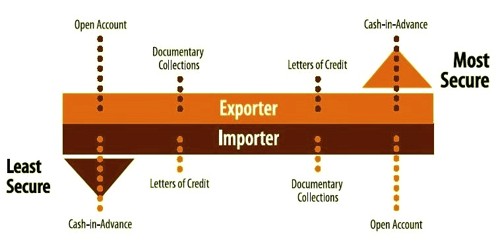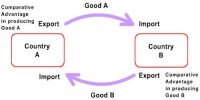International trade refers to the trade between two or more countries, where both of the countries exchange their capital, goods, and services. It is the exchange of goods and services across country borders.
Common forms of Payment for International Trade –
- Cash-in-Advance
With cash-in-advance payment terms, an exporter can avoid credit risk because payment is received before the ownership of the goods is transferred. For international sales, wire transfers and credit cards are the most commonly used cash-in-advance options available to exporters. With the advancement of the Internet, escrow services are becoming another cash-in-advance option for small export transactions. However, requiring payment in advance is the least attractive option for the buyer, because it creates unfavorable cash flow. Foreign buyers are also concerned that the goods may not be sent if payment is made in advance. Thus, exporters who insist on this payment method as their sole manner of doing business may lose to competitors who offer more attractive payment terms.
- Letters of Credit
Letters of credit (LCs) are one of the most secure instruments available to international traders. An LC is a commitment by a bank on behalf of the buyer that payment will be made to the exporter, provided that the terms and conditions stated in the LC have been met, as verified through the presentation of all required documents. The buyer establishes credit and pays his or her bank to render this service. An LC is useful when reliable credit information about a foreign buyer is difficult to obtain, but the exporter is satisfied with the creditworthiness of the buyer’s foreign bank. An LC also protects the buyer since no payment obligation arises until the goods have been shipped as promised.
- Documentary Collections
A documentary collection (D/C) is a transaction whereby the exporter entrusts the collection of the payment for a sale to its bank (remitting bank), which sends the documents, that its buyer needs to the importer’s bank (collecting bank), with instructions to release the documents to the buyer for payment. Funds are received front the importer and remitted to the exporter through the banks involved in the collection in exchange for those documents. D/Cs involve using a draft that requires the importer to pay the face amount either at sight (document against payment) or on a specified date (document against acceptance). The collection letter gives instructions that specify the documents required for the transfer of title to the goods. Although banks do act as facilitators for their clients, Dies to offer no verification process and limited recourse in the event of non-payment. D/Cs are generally less expensive than LCs.
- Open Account
An open account transaction is a sale where the goods are shipped and delivered before payment is due, which in international sales is typically in 30, 60 or 90 days. Obviously, this is one of the most advantageous options to the importer in terms of cash flow and costs, but it is consequently one of the highest risk options for an exporter. Because of intense competition in export markets, foreign buyers often press exporters for open account terms since the extension of credit by the seller to the buyer is more common abroad. Therefore, exporters who are reluctant to extend credit may lose a sale to their competitors. Exporters can offer competitive open account terms while substantially initiating the risk of non-payment by using one or more of the appropriate trade finance techniques covered later in this Guide. When offering open account terms, the exporter can seek extra protection using export credit insurance.
- Consignment
Consignment in international trade is a variation of open account in which payment is sent to the exporter only after the goods have been sold by the foreign distributor to the end customer. An international consignment transaction is based on a contractual arrangement in which the foreign distributor receives, manages, and sells the goods for the exporter who retains title to the goods until they are sold. Clearly, exporting on consignment is very risky as the exporter is not guaranteed any payment and its goods are in a foreign country in the hands of an independent distributor or agent. Consignment helps exporters become more competitive on the basis of better availability and faster delivery of goods. Selling on consignment can also help exporters reduce the direct costs of storing and managing inventory. The key to success in exporting on consignment is to partner with a reputable and trustworthy foreign distributor or a third-party logistics provider. Appropriate insurance should be in place to cover consigned goods in transit or in possession of a foreign distributor as well as to mitigate the risk of non-payment.
















